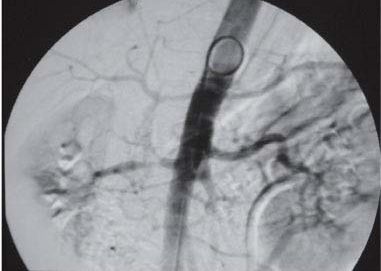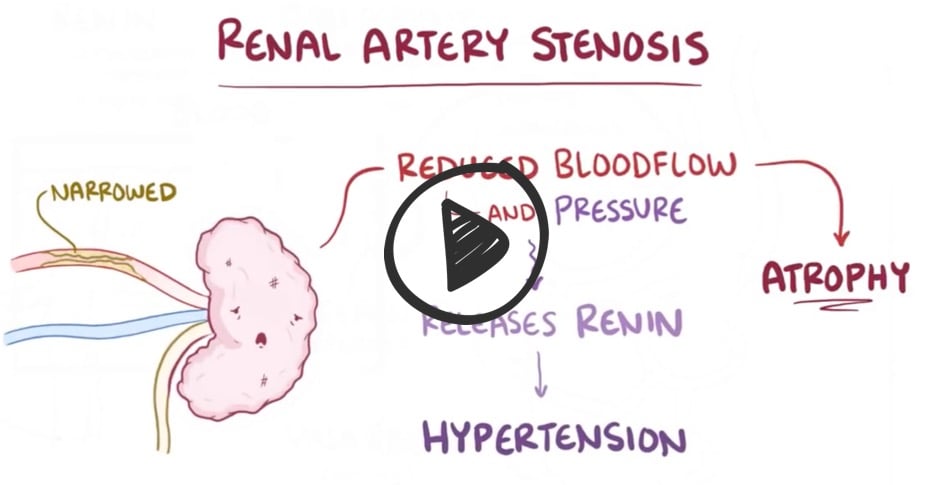Patient will present as → a 69-year-old man with a 55-pack-year smoking history, diabetes type II, and hyperlipidemia presents to his primary care clinic for an annual exam. He has no complaints. He reports that his blood glucose has been under tight control and that he has not smoked a cigarette for the past 5 months. Vital signs are HR 69 bpm, BP 180/100 mmHg, RR 12/min, and O2 saturation 99% on room air. Physical examination is notable for bruits bilaterally, just lateral of midline near his umbilicus. You initiate an anti-hypertensive medication, but his blood pressure continues to be suboptimal. Creatinine is 3.5.
Renal artery bruit (with bowel sounds)
Renal artery stenosis is the narrowing of one or both renal arteries, most often caused by atherosclerosis or fibromuscular dysplasia.
- This narrowing of the renal artery can impede blood flow to the target kidney, resulting in renovascular hypertension – a secondary type of high blood pressure.
May hear a renal artery bruit on auscultation
- Patients may present with HTN before age 30, HTN with CAD or PVD history, Hypertension resistant to three or more drugs
- If a patient is placed on an ACE inhibitor and suddenly develops acute renal failure or a sharp rise in BUN/CR, you should think of renal artery stenosis
Stenting of renal arteries
- Treatment is with percutaneous transluminal angioplasty (PTA) plus stent placement or with surgical bypass of the stenotic segment
- Usually, an extensively infarcted kidney must be removed if revascularization is not expected to result in functional recovery
- In patients with renal artery stenosis, especially those with stable renal function, the most appropriate initial management is medical management with antihypertensive medications
- ACE inhibitors and ARBs can be used in unilateral and, if glomerular filtration rate (GFR) is monitored closely, in bilateral renal artery stenosis
- Additional antihypertensive medications are frequently required
Question 1 |
Acute glomerulonephritis Hint: Usually presents with hematuria, proteinuria, and sometimes hypertension, but not typically with sudden severe hypertension. | |
Renal artery stenosis | |
Chronic kidney disease Hint: Develops gradually and is not typically associated with sudden severe hypertension. | |
Renal cell carcinoma Hint: Can cause flank pain and hematuria, but sudden severe hypertension is less common. | |
Pyelonephritis Hint: Presents with fever, flank pain, and urinary symptoms, not typically with severe hypertension. |
Question 2 |
Renal ultrasound with Doppler Hint: Useful but less sensitive than CT angiography for detecting renal artery stenosis. | |
CT angiography of the renal arteries
| |
Magnetic resonance angiography (MRA) of the renal arteries Hint: An alternative to CT angiography but may be less available or contraindicated in some patients. | |
Renal biopsy Hint: Not indicated in the initial evaluation of renal artery stenosis. | |
24-hour urine collection for metanephrines Hint: Used to diagnose pheochromocytoma, not renal artery stenosis. |
Question 3 |
Medical management with antihypertensive medications | |
Immediate surgical revascularization Hint: Considered in cases with refractory hypertension or deteriorating renal function. | |
Percutaneous transluminal renal angioplasty with stenting Hint: An option for certain patients, particularly those with fibromuscular dysplasia or those who fail medical therapy. | |
Chronic dialysis Hint: Indicated in end-stage renal disease, not as initial management for renal artery stenosis. | |
Nephrectomy Hint: Not a treatment for renal artery stenosis. |
Question 4 |
Hydrochlorothiazide-Triamterene | |
Prazosin Hint: An alpha-blocker like prazosin is generally safe in renal artery stenosis and does not directly worsen renal function. | |
Nifedipine Hint: This calcium channel blocker is often used to manage hypertension and does not have a direct deleterious effect on renal artery stenosis. | |
Verapamil Hint: Another calcium channel blocker, verapamil is typically safe in patients with renal artery stenosis. | |
Furosemide Hint: While loop diuretics like furosemide can be used cautiously in renal artery stenosis, they are not contraindicated as thiazide diuretics are. |
|
List |
References: Merck Manual · UpToDate


 Osmosis
Osmosis
